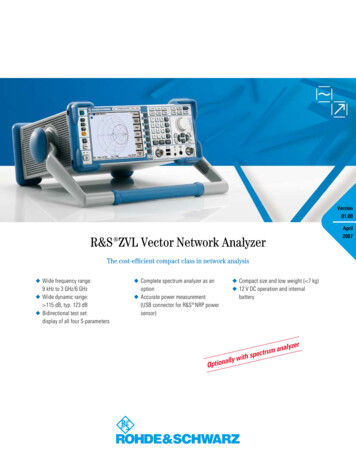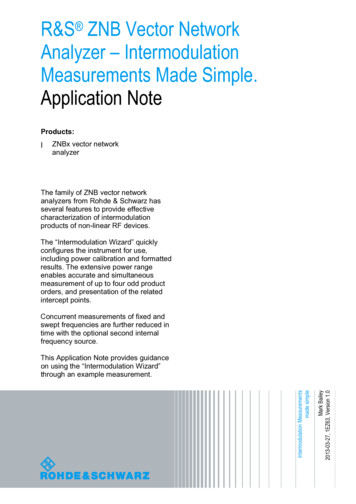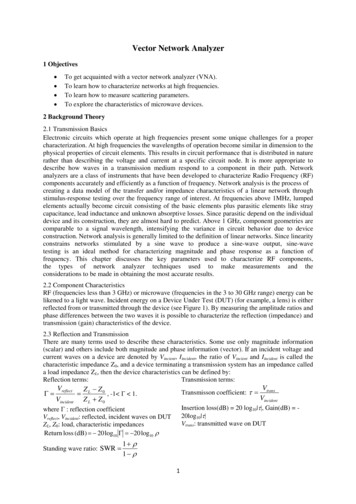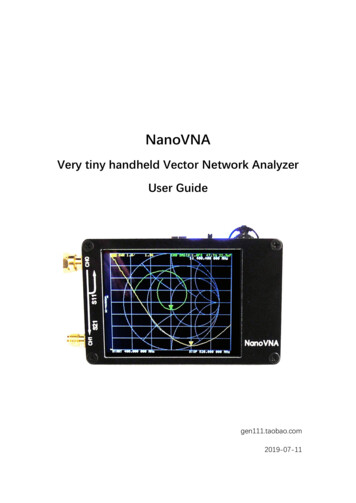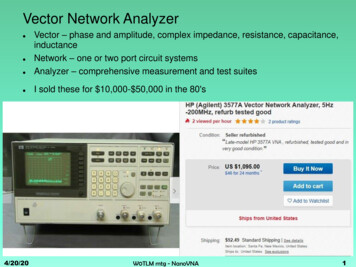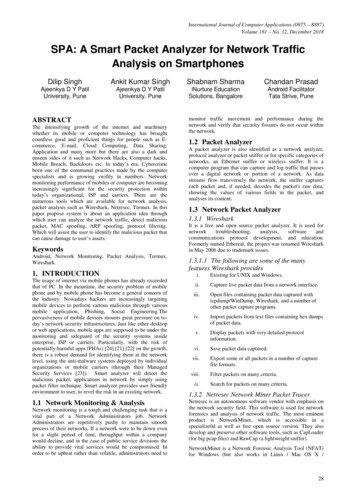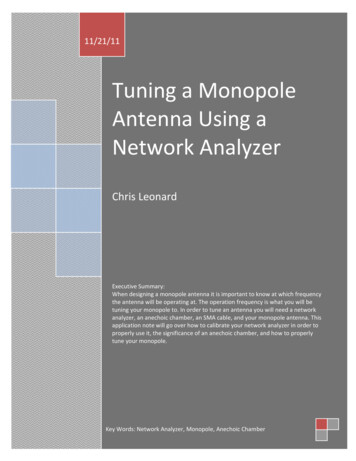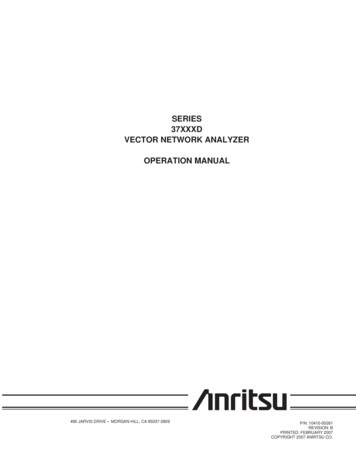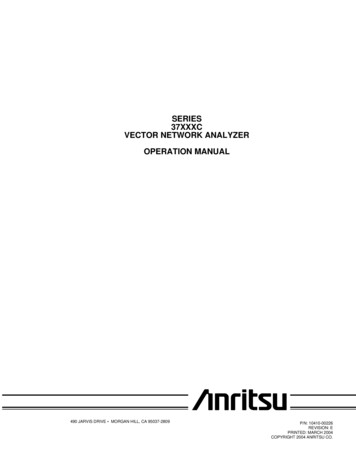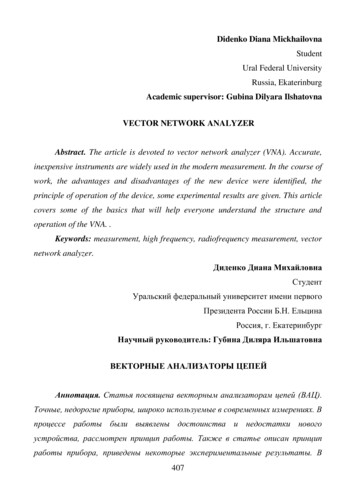
Transcription
Didenko Diana MickhailovnaStudentUral Federal UniversityRussia, EkaterinburgAcademic supervisor: Gubina Dilyara IlshatovnaVECTOR NETWORK ANALYZERAbstract. The article is devoted to vector network analyzer (VNA). Accurate,inexpensive instruments are widely used in the modern measurement. In the course ofwork, the advantages and disadvantages of the new device were identified, theprinciple of operation of the device, some experimental results are given. This articlecovers some of the basics that will help everyone understand the structure andoperation of the VNA. .Keywords: measurement, high frequency, radiofrequency measurement, vectornetwork analyzer.Диденко Диана й федеральный университет имени первогоПрезидента России Б.Н. ЕльцинаРоссия, г. ЕкатеринбургНаучный руководитель: Губина Диляра ИльшатовнаВЕКТОРНЫЕ АНАЛИЗАТОРЫ ЦЕПЕЙАннотация. Статья посвящена векторным анализаторам цепей (ВАЦ).Точные, недорогие приборы, широко используемые в современных измерениях. Впроцессе работы были выявлены достоинства и недостатки новогоустройства, рассмотрен принцип работы. Также в статье описан принципработы прибора, приведены некоторые экспериментальные результаты. В407
статье рассмотрены некоторые основы, которые помогут понять устройствои принцип работы ВАЦ очастотныеизмерения, векторный анализатор цепей.Introduction:The Vector Network Analyzer (VNA) is a modern piece of test gear that wasonce relegated to specialized measurements.Previously, this tool was large, expensive, and did not provide a reasonableperformance advantage to justify the increased cost. Older VNA was often delicate. Astechnology has advanced and test frequencies increased, however, the VNA paradigmhas drastically changed. The measurement flexibility increased as did the ease ofcalibration.The new VNA also allows new measurement possibilities such as accuratecorrection for cable losses or antenna input impedance over frequency. The latestgeneration VNAs can even accurately model nonlinear performance to predict changesin DUT (device under test) load or source impedances, something the legacy hardwarecould never do.Legacy hardware cannot measure phase data and, therefore, cannot remove theeffects of changes in cabling or load characteristics. In this paper, the efficacy of theproposed VNA is demonstrated via numerical simulations and experimentalmeasurements.The paper will then show that the VNA offers a low-cost alternative thatimproves reliability and accuracy, especially as our operating frequencies continue toincrease.The VNA is no longer an option. It is a necessary tool in modern measurement.This paper will discuss the disadvantages and differences between a vector networkanalyzer (VNA) and a scalar network analyzer (SNA).VNA – the basic408
Everyone who at least once heard about this device has always asked me thequestion "What kind of device is this?" To make the information easier to perceive let's start with the very basics.A vector network analyzer is a device that measures the characteristics of thesignal flow through the so-called device under test and the characteristics of the signalthat has been reflected from its ports. These very characteristics are called Sparameters. The S-parameter has indices that depend on the number of ports and thedirection of the signal. Each such parameter carries information about the amplitudefrequency characteristic (AFC) and the Phase-frequency characteristic (PFC).This knowledge will be enough to understand how measurements are made usingthe Vector Network Analyzer.MeasurementMeasurements on modern vector network analyzers are performed as follows: Asinusoidal signal is applied to the input of the device under test, and then two signalsare measured: the one that was reflected and the one that passed through the deviceunder test. Both of these signals will differ from test one in-phase and amplitude.In the process of studying the articles, we came across two types of networkanalyzers – a scalar network analyzer and a vector network analyzer. The difference,in simple terms, is that the Scalar Network Analyzer can only measure amplitude, whilethe Vector Network Analyzer can measure both amplitude and phase.For clarity, Figure 1 shows a simplified block diagram of a vector networkanalyzer. In this figure, the vector analyzer works in the forward direction, that is, theS-parameter has indices S21. A reference (with known characteristics) sinusoidalsignal is applied to the DUT. The signal characteristics will change at the output of thedevice under test. Next, the amplitude and phase detector will be involved, itdetermines how much the known value of the amplitude and phase has changed. Thiswill determine the characteristics of the device under test at one frequency. To measurethe response over a given frequency range, the vector network analyzer will repeatedlychange the frequency within the given range.409
Fig. 1. – Vector Network Analyzer.Application areaVector network analyzers have found very widespread use in our time. Mostoften, they are used to solve three main tasks:1. Measurement of passive and active characteristics of radio devices;2. Measuring the absorption and reflection of radio waves;3. Measurements in the medical, chemical, and food industries.Using a vector network analyzer, you can even measure grain moisture and manyother amazing parameters that at first glance are not related to radio measurements.Types of network analyzers.Previously, these were large and expensive devices. For example, in Figure 2, afour-port model of a vector network analyzer – VectorStar ME7838 is presented witha set of various cables and adapters that are used to connect to the measurement object.410
Fig. 2. – VectorStar ME7838.Such a vector network analyzer is commonly called an N-port. As mentionedabove, it is expensive, since for each of the ports it is necessary to duplicate most ofthe components – functional modules. The tolerance and high cost of this instrumentdid not justify the measurement capabilities, so two-port network analyzers werecreated, and then N-port switched matrix network analyzers.Of course, a decrease in cost could affect the deterioration of the quality of somecharacteristics, but we will consider this in another part of the article.Single-port VNAWe studied a one-port VNA that was designed by a group of scientists MohamedA. Abou-Khousa, Student Member, IEEE, Mark A. Baumgartner, Sergey Kharkovsky,Senior Member, IEEE, and Reza Zoughi, Fellow, IEEE. This VNA configuration is theeasiest to calibrate and use, and is significantly cheaper than other models. Figure 3shows a block diagram of this device.411
Fig. 3. – single-port VNA.This version uses an electronically controlled phase shifter, a standing wavemeter, and a device under test. The measuring device consists of a transmission line.Here it is made of a waveguide with a diode – detector. The reflected signal is bypassedwith the falling signal and a standing wave is formed in the transmission line. Thedistance along the length of the transmission line – L creates a DC voltage that isproportional to the power of the standing wave.Features:The characteristics of the proposed VNA depend on:1) detector noise level;2) phase-shift interspacing;3) number of phase shifts;4) DUT reflection coefficient, i.e. low and high reflection coefficients;5) quality of the phase shifter, i.e. return and insertion losses;6) detector characteristics;7) repeatability in producing phase shifts [1, p. 3].Measurement resultsWe have studied the results of experiments that were done using the VNAHP8510C and the proposed analyzer. Performance graphs are shown in the figuresbelow (Figure 4).412
Fig. 4. – Results of the experiments.The measurements on the proposed VNA correlate with those on the HP8510Cnetwork analyzer. This means that the proposed VNA offers reasonably accuratemeasurements of the complex reflectance. The coincidence of the results was up to 51points in the measurement band without smoothing.Also, repeated measurements of the characteristics of the phase shifter showedthat they remain practically unchanged over time, which means that the proposed VNAis a reliable device.413
The experiments were carried out for 5 months and all this time thecharacteristics of the phase shifter were quite constant. Of course, you can accuratelycorrect for the better if you use a higher quality phase shifter, thereby reducing theinsertion loss.ConclusionVector network analyzers are modern and necessary equipment. As with anymeasuring device, the VNA has its own measurement errors. But the high cost andcomplexity of measurements were unjustified.There are now many more forgiven VNA configurations with lower cost, easeof calibration, and ease of measurement.Vector network analyzers are the future because the operating frequency rangeis increasing, new materials are being created that need to be investigated. All these aretasks of the VNA, which with each new step in the development of the VNA aresimplified in their solution.REFERENCES1. Novel and Simple High-Frequency Single-Port Vector Network Analyzer.IEEE Transactions on Instrumentation and Measurement. – 2010. – Text: electronic. –URL: https://ieeexplore.ieee.org/document/5290122 (Reference date 20.10.2020).2. The Vector Network Analyzer – An Essential Tool in Modern ATEMeasurements. IEEE Instrumentation & Measurement Magazine. – 2012. – Text:electronic. – URL: https://ieeexplore.ieee.org/document/6263979 (Reference date15.11.2020).414
in simple terms, is that the Scalar Network Analyzer can only measure amplitude, while the Vector Network Analyzer can measure both amplitude and phase. For clarity, Figure 1 shows a simplified block diagram of a vector network analyzer. In this figure, the vector analyzer works in the forward direction, that is, the S-parameter has indices S21.
